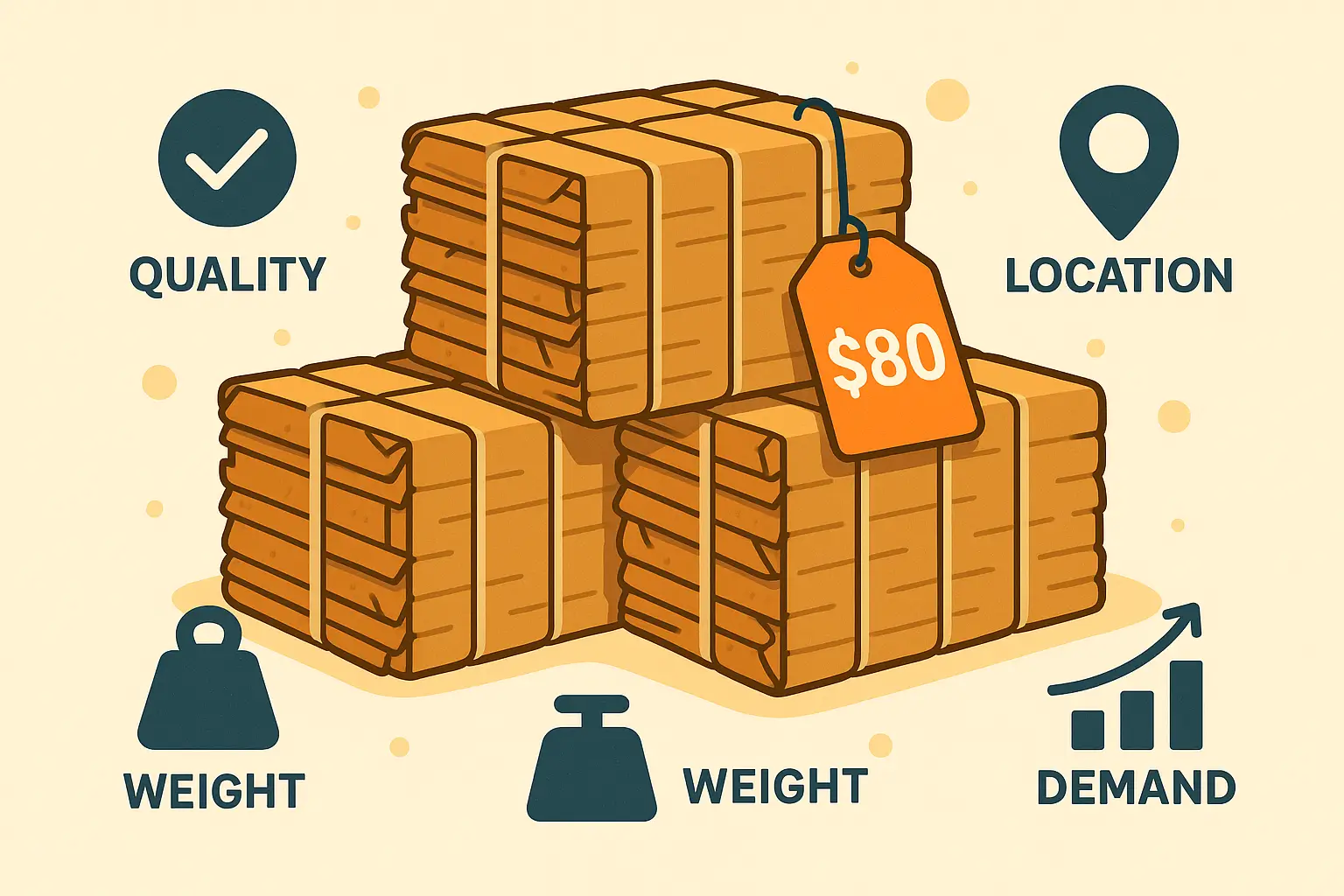Key Takeaway: The cost of a bale of cardboard varies widely—from approximately $20 to $300 per metric ton (equating to $6–$90 per typical 300–900 kg bale)—depending on geography, bale weight and dimensions, material quality, market demand, and logistical factors. Understanding these variables enables businesses and recyclers to optimize revenue, reduce waste-management expenses, and capitalize on recycling markets.
1. Price Ranges per Metric Ton
Across major markets, the price paid for recycled cardboard bales typically falls into the following broad ranges:
- North America (U.S.) – Average: $40–$95 USD/ton – Low: $20–$40 USD/ton – High: $150–$300 USD/ton during peak demand
- United Kingdom – £50–£150 per tonne (≈$63–$190 USD) from 2022–2024 – Current UK average: £85 per tonne (≈$108 USD)
- Global Commodity Range – $20–$210 per ton over the last five years, reflecting global pulp-fiber market swings
These per-ton figures must be converted to bale-specific costs by factoring bale weight.
2. Typical Bale Weights and Corresponding Costs
A “mill-size” cardboard bale commonly weighs 500‒1,200 lb (225‒545 kg), though smaller bales may be 300–400 kg (660–880 lb) and larger industrial bales can exceed 1 metric ton.
| Bale Weight | Price Range ($/ton) | Cost per Bale |
|---|---|---|
| 300 kg (0.3 t) | $20–$300 | $6–$90 |
| 500 kg (0.5 t) | $20–$300 | $10–$150 |
| 900 kg (0.9 t) | $20–$300 | $18–$270 |
| 1,200 kg (1.2 t) | $20–$300 | $24–$360 |
For example, an average 660 lb (300 kg) bale has been worth between $6 and $63 in recent years, reflecting per-ton prices of $20–$210.
3. Factors Influencing Cardboard Bale Price
3.1 Material Quality
- Clean corrugated cardboard (free of contaminants such as tape, food residue, plastic liners) commands premiums—up to 25% higher—because it reduces processing costs.
- Mixed or soiled cardboard may incur discounts or even negative pricing (i.e., tip fees) in regions where contamination burdens recyclers.
3.2 Bale Density & Preparation
- Higher bale density (more weight per cubic foot) lowers transport costs per ton and often results in a per-ton price premium.
- Proper strapping and consistent bale dimensions facilitate loading, leading to more favorable bids from buyers.
3.3 Market Demand & Global Commodity Cycles
- Prices fluctuate seasonally (e.g., holiday shipping peak) and cyclically with global pulp-fiber supply and consumer-goods manufacturing.
- Periods of high demand (e.g., packaging surges during e-commerce growth) can drive per-ton rates toward the upper end of $200–$300.
3.4 Geographical Location & Transportation
- Proximity to mills or large scrap-yard hubs reduces freight costs and may yield higher net prices.
- Remote locations or areas with limited processing capacity may see net prices 20–50% below national averages.
3.5 Volume Commitments & Contract Terms
- Bulk sellers (monthly > 50 bales) often negotiate volume discounts but also secure more stable, higher per-ton rates.
- Spot sellers with one-off loads typically receive lower or more volatile bids.
4. Scrap-Yard Payouts and Recycling Center Rates
| Outlet Type | Typical Payout | Basis |
|---|---|---|
| U.S. Scrap Yards (average) | $40–$95 USD/ton | Updated bi-weekly |
| U.K. Commercial Recyclers | £50–£150 per tonne | 2022–2024 range |
| Municipal Recycling Centers (U.S.) | –$30.37/ton (tip fee) to $30.95/ton | Larimer County, small bales vs. delivered |
- Some municipal centers charge tip fees on mixed recyclables but pay for properly baled cardboard (e.g., $30.95/ton paid for baled cardboard delivered without re-baling in Larimer County).
- Commercial scrap yards in major U.S. markets currently pay $40–$95 USD/ton, with occasional peaks up to $120 USD/ton in high-demand states.
5. Cost-Saving Benefits Beyond Bale Revenue
In addition to direct revenue from bale sales, baling cardboard can deliver significant operational savings:
- Waste Hauling Reductions: Baling reduces volume by up to 80–90%, lowering collection frequency and hauling fees.
- Floor-Space Savings: Baled cardboard occupies significantly less storage space than loose material, optimizing warehouse capacity.
- Labor Efficiency: Automated or semi-automated balers decrease manual handling, cutting labor costs by up to 30% in high-volume operations.
- Environmental & Compliance Benefits: Improved recycling percentages can contribute to sustainability goals, potentially reducing regulatory fines or qualifying for green incentives.
6. Strategies to Maximize Bale Value
- Maintain High Purity: Remove all non-cardboard materials (plastic, foam, metal) before baling.
- Optimize Bale Weight & Density: Aim for “mill-size” bales (500–1,200 lb) with consistent dimensions to qualify for premium pricing.
- Negotiate Volume Contracts: Leverage consistent, high-volume output to secure long-term, favorable per-ton rates.
- Monitor Market Trends: Align sales with periods of high demand (e.g., pre-holiday packaging surges) to capture top market rates.
- Select Ideal Partnerships: Choose recyclers or scrap yards with transparent pricing and reliable logistics support to minimize hidden fees.
7. Regional Cost Examples
| Region | Price Range per Ton | Bale Weight (Example) | Estimated Cost per Bale |
|---|---|---|---|
| California (Perris) | $95 USD/ton | 500 kg | $47.50 |
| Texas | $70–$120 USD/ton | 1,000 kg | $70–$120 |
| New York | $40 USD/ton | 800 kg | $32 |
| London, U.K. | £85 per tonne | 600 kg | £51 (≈$65 USD) |
| Midwest, U.S. (average) | $40–$80 USD/ton | 300 kg | $12–$24 |
Estimates are illustrative; actual prices vary with quality, demand, and logistics.
8. Conclusion
The price for one bale of cardboard depends primarily on:
- Its weight (commonly 300–1,200 kg)
- The prevailing per-ton rate ($20–$300/ton globally; $40–$95 USD/ton in the U.S.; £50–£150 /tonne in the U.K.)
- Material purity, density, location, and contract terms
A typical 500 kg bale in the United States can yield $10–$150, with averages clustering around $20–$60 depending on market conditions. By optimizing quality, bale specifications, and timing of sales, businesses can maximize both their recycling revenue and operational savings.



Leave a Reply